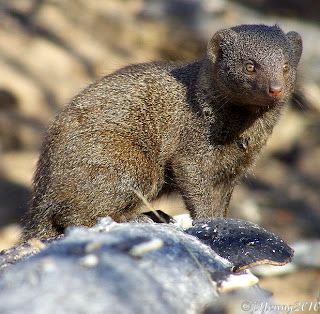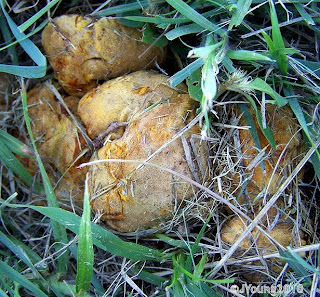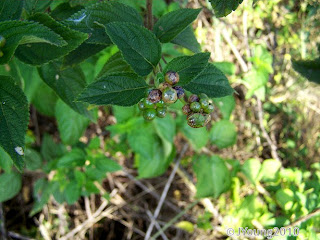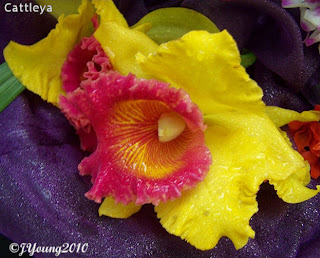A better look at the root formation. They do not require soild to grow in and need very little water to thrive.

Going to stay in the bush for a few days, weeks, months, in order to do photography, there are a few things which are absolutely essential.
1. Hat – this is the top most important thing you should take. Forget your camera if you want to forget something but NOT a hat. Even in winter, the sun can get mighty warm, especially if you are not used to it.
2. This might sound stupid, but next in order of importance is a cotton, long sleeve shirt. You might get hot in it but it prevents you from getting sunburn and in the summer, helps keep mosquitoes from biting.
3. If you are prone to those nasty little things which bite, a good mosquito repellent comes in handy.
4. Wear comfortable walking shoes, preferably some which you have worn many times as this is not the time to get a blister.
5. Always have a bottle of water, even coffee or a beer will do. This comes in handy when you find a nice shady spot and want to take a break.
6. Depending on how long you are going to be out, take a couple of sandwiches along, but even on a short walk, an apple or orange adds to your moisture intake.
7. Now, if you are going to take pictures, please remember to pack in your camera plus some spare batteries and/or an extra memory card. Then don’t forget the binoculars.
8. The time of day you go for a walk is important, early in the morning or late afternoon being the best as then you miss the heat and your light is at its best. Also, early mornings are better to get good bug pictures as they have still not warmed up and are clinging to grass and weeds.
I have seen people going on walks which bog themselves down with all kinds of things including torches, night sticks, bandages, whistles, etc. At the end, their rug sacks are so heavy with things they MIGHT need, they do not enjoy the walk for what it is. By all means talk a walking stick if you feel you need it or anything else you might classify as essential, but remember, you have only two hands and when you want to take a picture, you need those hands to be free.
When doing photography, especially close-ups a few rules go a long way to getting a picture:
1. Wear old clothes so you are not afraid to get down and dirty if you have to.
2. Listen – many, many times, sound is what gives away the location of something, so stop and listen to your surroundings.
3. Look and observe – many times I pick up something just by a color which should not be there or the slight movement of something. For example, today I saw a piece of bark moving. Now as far as I know, bark should not move as it does not have legs so when I stopped and peered down, I discovered the most amazing little insect. Look for leaves which are freshly eaten as this is a good indication there is some kind of bug or beetle having a meal, sometimes under the leaf.
Be attuned to what the birds and animals around tell you. Birds will screech when they see something which is a threat to them such as lizards, raptors etc and an animal will scatter and take off at the faintest sight or sound of a predator.
4. Know where to find things. So often things like spiders are found on flowers as that is where the flying insects come to collect nectar. Lizards like to bask on rocks in the sun and butterflies are attracted to wild flowers or rotting fruit. It is at these places where you will also find things like mantis which prey on the above.
5. Above all, be patient. See where the insects favorite perches are and go and sit there without movement for a while and they will come back to them time and again. Almost all dragonflies have a spot he prefers.
6. Don’t move quickly or make a noise or let your shadow go over the insect. All of these frighten them off very quickly.
So now you know all my tricks and I can add only two more pieces of advice: Ladies, don’t try to go for a walk in high heel shoes and men, wearing socks on a walk at the end of summer is going to get them full of burrs and weeds, so leave them off. LOL!!
Oh and one more thing …… don’t get lost!! :)
And I almost forgot the most important of all ….. enjoy yourself!! I certainly will!!
 At one of the places we went, they had built a platform and you could buy treats for the giraffe and stand there and feed him. Naturally the kids loves this close-up encounter with an animals whose head is usually 20 foot above theirs.
At one of the places we went, they had built a platform and you could buy treats for the giraffe and stand there and feed him. Naturally the kids loves this close-up encounter with an animals whose head is usually 20 foot above theirs. I ended up taking a really CLOSE shot of its mouth. A bit hairy don't you think? LOL!! For more info, click here.
I ended up taking a really CLOSE shot of its mouth. A bit hairy don't you think? LOL!! For more info, click here. One of the othr places we went they had some Caracal which they fed with small chickens.
One of the othr places we went they had some Caracal which they fed with small chickens.






 A lot of time is spend grooming themselves and each other. I guess it is hard to lick behind your own ears. LOL!!
A lot of time is spend grooming themselves and each other. I guess it is hard to lick behind your own ears. LOL!!

































